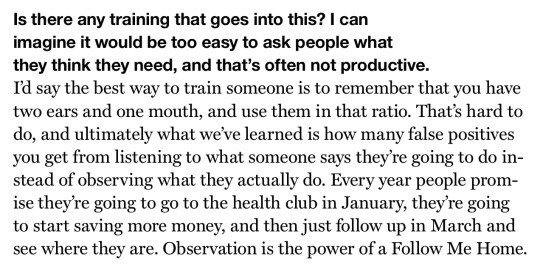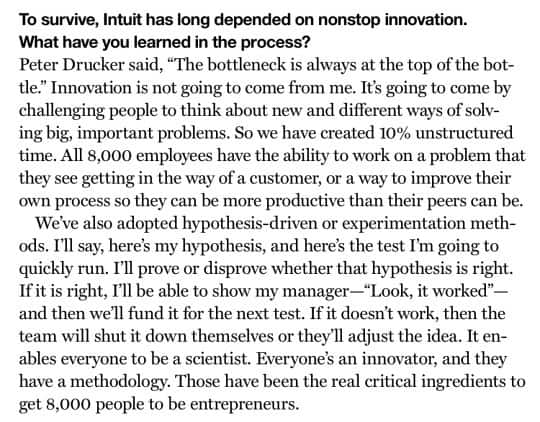
I was happy to see this article in FORTUNE's recent issue: “Brad Smith, Intuit CEO: How To Be A Great Leader: Get Out Of The Way.”
Smith (@IntuitBrad) talks about the Lean Startup concept often called “getting out of the office” to see how customers live and work. Toyota would call this “Genchi Genbutsu” (go and see) and they do this with American customers, for example, to better understand the needs of the market here. “Design thinking” and IDEO would call this ethnographic research – either way, it's smart business to understand the problems your customers need to solve.
From the article:
“We pride ourselves on two core capabilities that differentiate us and allow us to deliver solutions that truly change people's financial lives. The first is customer driven innovation, a mindset and methodology that helps us uncover important, unsolved problems. Customers are at the heart of everything we do. We conduct nearly 10,000 hours of follow me homes a year where we observe customers where they live, work and do business – from home offices and coffee shops to rural farms in India.”
“Follow me homes” = genchi genbutsu. And “follow me homes” is probably a better word to use here in the U.S. Could healthcare providers or medical device makers learn similar lessons by following patients home (with their permission, of course)?
Some additional detail from the iPad edition of the publication:

I love the idea that Smith, as a busy CEO, participates in this, as well.
How do they train people?

Two ears, one mouth. A simple principle that's sometimes hard to follow. You need to actually observe customers, not just survey them. Customers sometimes lie (such as, “I work out every day”).
Smith adds:
“At the end of the day, it's about empowering individuals to contribute ideas and make an impact, as well as setting goals that challenge employees to step outside their comfort zone.”
How does Intuit create a culture of innovation and employee engagement? It starts at hiring:
“As each new hire begins, as with all employees, we expect them to assume the role of their own business within our business. I call it “Me, Inc.” That perspective accelerates everything they do -from the questions they ask to the programs they propose. The creativity goes through the roof. They are in a position to be creative, to be more efficient, and to find ways to increase revenue and reduce the bottom line. We have no managers; we have leaders who are resources and examples of what we espouse. While I have an open door, I expect individuals to come to me or any leader with several proposed answers to the questions they have. Nine out of ten times, they have the answer and my role is to support them.”
We see this in the Kaizen approach to continuous improvement and Lean. Leaders don't have to have all of the answers. They need to create an environment where it's safe to point out problems and then ask them “what do you think we can do?” They often have the answer or at least a good idea that can be discussed and/or tested in practice. Again, the boss doesn't need to have all of the answers. This simple idea is often a big mind shift change for leaders.
And Smith also shares:

I love the “bottleneck at the top” quote. Kaizen… continuous improvement… and a Lean culture start at the top. If the CEO participates in Kaizen and asks people to participate, they will. If the CEO asks, “What is the problem you're trying to solve? What is the root cause?”, that models the right behaviors and sets a powerful example.
Can you free up 10% of your employees' time to work on improvement? Can you use experimental approaches like PDSA-based Kaizen to encourage people to TEST proposed changes? Can your leaders get out of their way?
Smith presented at the 2011 Lean Startup Conference (see my notes here) and he's appeared in a few videos talking about Lean leadership:
“Leaders are less known for the answers they have, but for the questions they ask.”
Please scroll down (or click) to post a comment. Connect with me on LinkedIn.
Let’s work together to build a culture of continuous improvement and psychological safety. If you're a leader looking to create lasting change—not just projects—I help organizations:
- Engage people at all levels in sustainable improvement
- Shift from fear of mistakes to learning from them
- Apply Lean thinking in practical, people-centered ways
Interested in coaching or a keynote talk? Let’s start a conversation.









